Take what you have gathered from
Coincidence
— Henry Neville — decoding from grids
"I don't think they play at all fairly," Alice began, in rather a complaining tone, "and they all quarrel so dreadfully one can't hear oneself speak — and they don't seem to have any rules in particular: at least, if there are, nobody attends to them — and you've no idea how confusing it is."
Alice in Wonderland, Lewis Carroll
|
Hypothesis:
Given a random plain English text exceeding 100 characters, then a persistent investigator working within the rearrangement and interpretation rules established by James, Goding and Leyland will discover encoded words and sequences from which a conclusion can be drawn.
Testing the hypothesis:
I decided to use Brenda James' "random inscription" (BJ329) as an independent text and to work with the grid process.
| 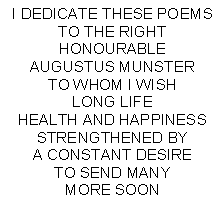 |
|
For the first setting I followed conventional practice and laid the inscription out on a 12 character wide grid (BJ18) and looked for further clues. The first word I noticed, starting from the top left, was DEEP in a neat cluster format (BJ18). Deep what? I proceeded to the right and found the TT clue. This clue I understood to be significant (see especially LG32). But then two characters further to the right I found two THEs one placed precisely above the other. Clearly this double definite article was an indicator. Yes, I see, the word "deep" can be used as adjective, adverb or noun, the definite article indicates that we should consider it as a noun. The COD gives the meanings for the noun deep as "deep part(s) of the sea, abyss, pit."
The next clues are the word THUG and an arrangement that suggests you can have wealth or health but not both. The sets of three letters, SSS and NNN are interesting but the meaning is obscure. Then I noticed the word ACID in reverse in row 1 and the word NOOSE in reverse and with an alternative configuration in rows 11 and 12. A thought came to mind: there appeared to be a sinister sense to the code – a hint to use a setting of 13?
|
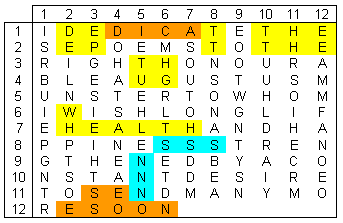
Setting 1.
|
|
This setting of 13 first revealed a couple points but not anything remarkable. The wealth/health dilemma was more apparent. Edgar Poe, the master of suspense and mystery appeared in row 2. But then I noticed the last row contained MORE SOON, complete and unencumbered; somewhat like SETTING FORTH in BJ18. I was close, but not there. The reverse spelling of NOOSE (the alternative version now slightly enhanced) and ACID persisted. What if I entered the characters into the setting in reverse order?
|
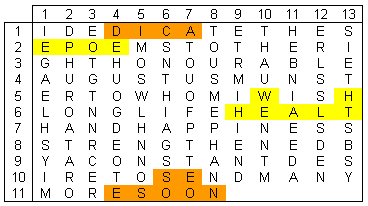
Setting 2.
|
|
Note that setting 3 is not simply a reflection of setting 2. Because 13 is not a factor of 138 we have a new arrangement – compare the top row of one setting with bottom row of the other to see this point. NOOSE and ACID are now the right way about, SSS is back and NOSTER, the second word of the Lord's Prayer in Latin has appeared. But look at the turquoise cluster in row 8, 9 and 10. Take the letters 2 at a time (check my work). ME PH IS TO PH (reused as in BJ27, LG6) EL ES (the S reused) – Mephistopheles, the name allocated to the devil in the Faust legend (BDPF). I was convinced!
But I still felt something was eluding me – I had the clues but I had not made the identification. I decided to try the technique of anagrams (BJ112, 113). I worked with the columns of setting 2. From column 5 I found MOON WISHNS, perhaps an attempt at "moon wishes" and from column 3 I found TO ENTER RCNG, perhaps an attempt at "to enter, ring." A thought occurred to me – only column 11 has the same letters in both settings 2 and 3. This is a natural consequence of 138 characters set into rows of 13. So column 11 was the one to work on – it would (if resolvable) give a solution for both settings. I arrived at the anagram BEANIE HEAD – hardly an imposing phrase, but real nevertheless. (Beanie is listed in my 1976 COD.) The resulting rearrangements are shown in settings 4 and 5.
|
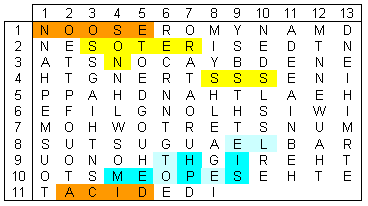
Setting 3.
|
|
Setting 4 – look at the yellow cluster and we have Herman Munst(er), the leading character in the 1960's TV series The Munsters. So the prestigious sounding Augustus is really just an American sit com character! The peculiar shape of Herman's cranium may explain the appellation "beanie head." (By the way the cross formed with HER, MAN and MUNST lying abreast BEANIEHEAD is a papal cross (BDPF). This links with the Latin word "noster.") In this setting note also the cluster of S's and the word DEAD
|
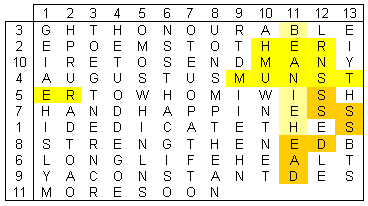
Setting 4.
|
|
Setting 5 – here, working back-to-front and upside-down, we have Herman Munster again but with MUNSTER unbroken. The S cluster is there also, together with the now familiar NOOSE and ACID. Unexplained at present are the strings TTT and OOO.
It wasn't until I looked back at setting 1 which has the S's in the most straightforward form, that their meaning was apparent – it was the "Six hundred threescore and six" (SixSixSix) of Revelations 13:18. (I assume the NNN in setting 1 is a little quirky touch of the "back-to-front and upside-down" method – NineNineNine.)
|

Setting 5.
|
Commentary:
Subjected to established techniques the plain text has yielded considerable data. The plain text presented no opportunity for interpretation – it contained no dots, dashes or extraneous spaces that could be ignored or included at whim.
It is worth noting that some of the data is a natural consequence of the original text. ACID, POE, one generation of SSS per setting, NOOSE and, of course, MUNSTER are buried in there regardless of the arrangement into a setting. Other data such as HERMAN and MEPHISTOPHELES were not.
The exposure of the word "Mephistopheles" is interesting. Mephistopheles is the other character (so to speak) in Christopher Marlowe's play, Doctor Faustus. (Marlowe was a contemporary of Shakespeare until he was killed in a public house. The death was awkward for Marlowe who could no longer write plays; it also has proven awkward for those speculators who have advanced the idea that Marlowe wrote Shakespeare's plays.) The word Mephistopheles is a link between James' work and her example dedication. There are two possibilities:
1) Coincidence (at some indeterminable level)
2) James subconsciously encoded the word into her example dedication.
The use of an anagram for rearranging rows or columns can provide an opportunity for a selective process. Because A appears twice in BEANIE HEAD I had two options for a row to follow the one containing HER. One row produced HERMAN, which suited my case, the other would have produced HEREAL, a sequence of no consequence (perhaps).
James had a similar choice in her TEST THE FORGE anagram (BJ112) where E appears thrice. She produced a cluster YRNEHE, itself an anagram of HENRY and which she noted as significant. However, had she used different columns, the cluster would have been YONGHT or YINRHI yet the TEST THE FORGE anagram would have still been satisfied.
The bulk of the data is discovered by inspection, so important attributes for an investigator are the ability to spot significant letter sequences and a broad knowledge of English. I suspect that a championship Scrabble player with a liberal arts background would be extremely productive.
Conclusion:
For this one text only, the hypothesis has been demonstrated. However, there are firm indications that the established rules and techniques of James, Goding and Leyland would provide enough flexibility to manipulate the chance sequences that may occur in other texts into exploitable data.
Return to Henry Neville Index
Last update
August 17, 2014
Mal Haysom
initial posting 29/03/2009
|





